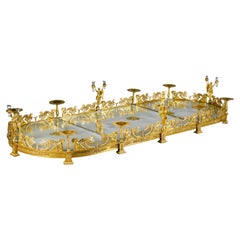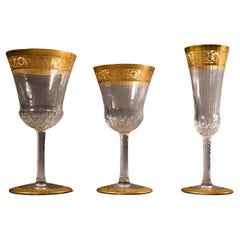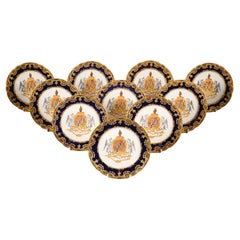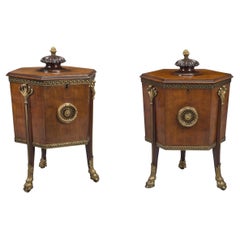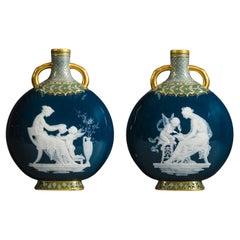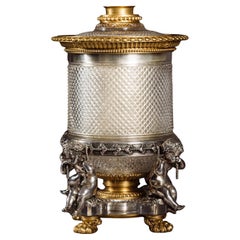Adrian Alan Serveware, Ceramics, Silver and Glass
to
32
29
3
3
2
2
2
1
18
18
13
10
7
32
30
13
8
7
7
32
32
32
3
3
2
2
2
An Empire Period Gilt-Bronze Three-Piece Surtout de Table, Attributed to Denière
Located in Brighton, West Sussex
A Palatial and Important Empire Period Gilt-Bronze Three-Piece Surtout de Table, Attributed to Denière, Paris.
Comprising three mirrored platform sections with a rectangular centra...
Category
Antique 1810s Centerpieces
Materials
Bronze
A Forty-Three Piece Table Service by La Cristallerie de Saint Louis
Located in Brighton, West Sussex
A Rare Crystal and Gilt Forty-Three Piece Table Service by La Cristallerie de Saint Louis. This fine and luxurious service is in the famous ‘Thistle’ pattern developed by La Cristal...
Category
Early 20th Century French Glass
Materials
Crystal
Set of Ten Sèvres-Style Armorial Cabinet Plates
By Manufacture Nationale de Sèvres
Located in Brighton, West Sussex
A Fine Set of Ten Sèvres-Style Armorial Cabinet Plates.
Marked to the reverse with blue underglaze interlaced ‘L’s’.
Each plate is finely painted and gilt with a dark powder-blue scalloped border and pendant husks, centred by the arms of the Loftus family, Earl’s of Ely.
The arms consist of a shield with supporters of two eagles, wings inverted, argent, each charged on the breast with a trefoil slipped azure, and motto 'LOYAL AU MORT'. The Earl’s coronet is surmounted by a helmet bearing the crest of a boar's head erased and erect.
A comparative Royal Worcester bowl...
Category
Antique 19th Century French Porcelain
Materials
Porcelain
A Rare Pair of George III Style Mahogany Cellarettes
By Conrath and Sons
Located in Brighton, West Sussex
A Rare Pair of George III Style Gilt-Bronze Mounted Mahogany Cellarettes.
This unusual pair of hexagonal cellarets have a hinged top with a knopped finial, opening to an interior fi...
Category
Antique 19th Century English George III Wine Coolers
Materials
Brass
A Pair of Mintons Pâte-sur-pâte Peacock Blue Moon Flasks
By Minton
Located in Brighton, West Sussex
A Pair of Mintons Pâte-sur-pâte Peacock Blue Moon Flasks, Decorated by Marc-Louis-Emmanuel Solon (1835–1913).
Date cypher for 1890. Recorded as shape no. 1819. Each signed 'L(ouis) Salon'. With gilt Mintons globe mark, impressed uppercase mark and retailer's mark for Phillips, Oxford Street, London, Faint impressed marks ‘1819’.
Each tinted and glazed parian vase of moon flask or pilgrim bottle...
Category
Antique 19th Century English Porcelain
Materials
Porcelain
A Cut-Crystal Glass, Gilt and Silvered Bronze Wine Cooler, By Baccarat
By Cristalleries De Baccarat
Located in Brighton, West Sussex
A Rare Cut-Crystal Glass, Gilt and Silvered Bronze Wine Cooler, By Cristalleries de Baccarat, Paris.
The removable lid with an central aperture to allow the bottle neck to protrude....
Category
Antique 19th Century French Wine Coolers
Materials
Bronze
A George II Style Silver Plated Warwick Cruet
Located in Brighton, West Sussex
A Fine George II Style Silver Plated Warwick Cruet.
The cinquefoil tray having a tall central handle with a leaf and figurative grip above a frame with a rococo armorial cartouche. ...
Category
Antique 19th Century English George II Serving Pieces
Materials
Silver Plate
A Fine Paris Porcelain Empire Coffee Service
Located in Brighton, West Sussex
A Fine Paris Porcelain Empire Gilt-Decorated and Floral Painted Coffee Service.
Comprising a coffee pot, hot-water pot, milk jug, sugar bowl...
Category
Antique 19th Century French Empire Porcelain
Materials
Porcelain
A Monumental Meissen Porcelain Figural Group of Mount Parnassus
By Meissen Porcelain
Located in Brighton, West Sussex
A Monumental Meissen Porcelain Figural Group of Apollo and the Nine Muses on Mount Parnassus.
Comprised of sixteen interlocking parts. Apollo standing holding a lyre and with Pegasus besides a tree, atop a rocky outcrop detailed with foliage and waterfalls above nine goddesses:
Calliope, seated and shown writing, representing eloquence and epic poetry.
Clio, seated with an open book and blowing a trumpet, representing history.
Erato, seated and holding a kithara, representing science and the arts
Euterpe, seated and holding a flute, representing music.
Melpomene, seated holding a knife and with one hand to her head, representing tragedy.
Thalia, seated and holding aloft mask, representing comedy and idyllic poetry.
Urania, seated with telescope and globe, representing astronomy and astrology,
Polyhymnia, standing with one hand raised and holding a book, representing sacred poetry.
Terpsichore, standing, representing dance.
Each piece exceptionally finely detailed and painted. The base portions with rocaille edges. On a later black polished wooden base.
Multiple blue crossed swords marks. Each piece titled to underside.
German, Circa 1880.
Mount Parnassus, is a spur of the Pindus Mountains in central Greece and was sacred to the ancient Greeks and in mythology to Apollo, the god of music and poetry and of the Sun and light. Mount Parnassus the mythical centre of poetry, music, and learning in ancient Greece was a popular theme in Barqoue and Rococo art, often substitutable with Athena’s arrival at Mount Helicon from the fifth book of Ovid’s “Metamorphoses”, where she asks the Muses to show her the new spring which gushed forth from the spot where Pegasus “with his hoof of horn opened the earth” (V, 250-260).
Here, the mountain, formed from rugged rock cliffs, culminates in a plateau on which the youthful Apollo stands and plays the lyre. The Castalian spring flows from beneath Pegasus’ hoof, representing the source of inspiration and attracting the nine muses, who embody the arts and inspire creation through song, music, and dance.
Mount Parnassus was created at the Meissen porcelain manufactory as a table centrepiece and an earlier version, apparently with only five muses, is listed in the inventory of the pastry shop of the Meissen manufactory manager and cabinet minister Heinrich Graf Brühl in 1753. The storage in the pastry shop of approximately 3,000 objects and dishes, including many individual parts for centrepieces, is related to their function as table decorations, replacing decorations previously made by the confectioner from perishable materials such as sugar or wax.
The purpose of this table decoration was as a feast for the eyes to accompany the feast of the banquet. The sculptural figurines often depicted a particular theme, with characters drawn from theatre and opera, from classical mythology or pastoral idylls. Allegories and mythological themes, such as the glorification of fine arts, were also popular. Stylistically, Mount Parnassus fits Kändler’s style of the 1740s, and was sold by Brühl in 1762 to Frederick the Great of Prussia who used mythology as a means of self-expression and had already ordered individual figures of Apollo and the Muses as table decorations in 1744. Today it is in the Museum of Applied Arts, Frankfurt (inv. no. M.L. 41). There is another version of Mount Parnassus, from the collection of Prince Alexander Dolgorukoff, in the Hermitage in Saint Petersburg.
The present version dates to the second half of the nineteenth century when there was a great revival of Kändler rococo figurines which were reissued and a “Second Rococo”. Another nineteenth century example is in the collection of the Museo Francesco Borgogna, Italy (inv. 1906, XIII, 19-20). These nineteenth century versions were made by the Meissen factory using Kändler's period models. It is recorded that a new version of Mount Parnassus, dating to the 1880s, was part of the Royal Porcelain collection in Dresden:
'In the porcelain collection there is a new version from the 1880s based on the old models, the largest group of this genre, the Parnassus, which shows the named muses all around on the lower part of the rock, each practising their own art, while on the top there is Apollo with the lyre and next to it the Castalian spring rises from the hoofbeat of Pegasus. Each figure is executed individually with its rocky background, and all the pieces are then fitted together, as we have already seen in his earlier, larger compositions. The rock pieces are finished off like a pedestal at the bottom with Rococo ornaments.' (Jean Louis Sponsel, Kabinettstücke der Meissner Porzellan-manufaktur von Johann Joachim Kändler, Leipzig, 1900, pp. 203-204).
Kunst und kunsthandwerk; monatsschrift herausgegeben vom Österreichischen museum fuer kunst und industrie, Vienna, 1894, v.7 pt.1, p.133.
Kari Berling, Das Meißner Porzellan und seine Geschichte. Leipzig 1900, S. 99, 187-200.
Helmuth Gröger, Johann Joachim Kaendler. Dresden, 1956.
Peter W Meister, Franz Adrian Dreier, Figürliche Keramik aus zwei Jahrtausenden. Kat Museum für Kunsthandwerk, Frankfurt. Frankfurt 1964, Nr. 90.
Rainer Rückert, Meißener Porzellan, 1710-1810. Kat. Ausst. Bayerisches Nationalmuseum München. München 1966.
Stefan Bursche, Tafelzier des Barock. München 1974, Abb. 300.
"Tafelaufsatz, Der Parnass", Auswahlkatalog, Museum für Kunsthandwerk (Frankfurt am Main, Germany), 1987, pp. 86-87.
Alfred Ziffer, ‘Meissener Porzellanplastik für fürstliches Interieur und Zeremoniell’, Keramos, Issue 241/242, pp. 29–52.
MEISSEN
The production of Meissen porcelain began in 1710 at the manufactory at Meissen...
Category
Antique 19th Century German Rococo Porcelain
Materials
Porcelain
A Pair Of Meissen Porcelain Mythological Figural Groups
By Meissen Porcelain
Located in Brighton, West Sussex
A Pair Of Meissen Porcelain Mythological Figural groups, of 'Neptune and Thetis' and 'The Triumphal Procession of Amphitrite'.
'Neptune and Thetis' modelled with the god of the sea ...
Category
Antique 19th Century German Rococo Porcelain
Materials
Porcelain
A Renaissance Style Faïence Coupe in The manner of Gien
By Gien
Located in Brighton, West Sussex
A Fine Renaissance Style Faïence Coupe in The manner of Gien.
This impressive faïence coupe is of inverted bell shape with Renaissance style decoration of strapwork, mythical beasts, trophies and armorial...
Category
Antique 19th Century French Renaissance Centerpieces
Materials
Porcelain
Berlin (KPM) Porcelain Plaque Of A Young Woman, In a Giltwood Frame
By Königliche Porzellan-Manufaktur (KPM)
Located in Brighton, West Sussex
A Very Fine Berlin (KPM) Porcelain Plaque Of A Young Woman, In a Giltwood Frame.
The plaque has an impressed KPM sceptre mark to the reverse with impressed number 315_255 and a letter H. A paper label for the studio of 'Franz Xavier Thallmaier, Mucnich'.
This fine KPM plaque is superbly painted with a portrait bust of a young woman holding a music scroll and a laurel branch, possibly representing St. Cecilia. The plaque is set in a giltwood frame.
Franz Xaver Thallmaier (1890-1910) established in Munich in 1890 one of the most prominent and successful porcelain painting studios in Germany. He employed a number of talented porcelain painters specialising in portraits and genre scenes after artists such as Joseph Stieler, Wilhelm Kray...
Category
Antique 19th Century German Porcelain
Materials
Porcelain, Giltwood
Napoleon III Decanter Set Attributed to Baccarat
By Cristalleries De Baccarat
Located in Brighton, West Sussex
A Gilt-Bronze and Cut-Glass Pagoda Form Cave à Liqueur, Attributed to Baccarat.
The shaped gilt bronze case finely cast with egg and dart moulding, acanthus fronds and musical tr...
Category
Antique 19th Century French Napoleon III Barware
Materials
Ormolu
A Worcester (Barr, Flight & Barr) Twenty-Eight Piece Part Dessert Service
By Barr, Flight & Barr Worcester
Located in Brighton, West Sussex
A Worcester (Barr, Flight & Barr) Porcelain Floral Painted and Gilt Vermicule Ground Part Dessert Service, Painted by William Billingsley.
Impressed and printed marks.
Comprising:
Two tureens and covers, each decorated on both sides.
Two oval dishes, 28 cm. wide.
Twenty-four plates each finely painted with a different floral panel, 21 cm. diameter.
Impressed and printed marks, England, Circa 1810.
Provenance:
J. Rochelle Thomas, London.
Abby Aldrich Rockefeller.
Laurance S. Rockefeller.
Alberto Pinto.
Literature:
Sandon John, Ewers-Tyne Collection of Worcester Porcelain at the Cheekwood Collection, Nashville, Tennessee, 2007, Item number 77 - a plate from this unique service identified as being the work of Billingsley. Only employed at Barr, Flight & Barr for a short period, initially as a painter and subsequently perfecting their porcelain bodies, Billingsley left in 1813 to set up the Nantgarw China...
Category
Antique 19th Century English Ceramics
Materials
Porcelain
Fine Pair of Vienna Style Porcelain Tureens and Cover
By Royal Vienna Porcelain
Located in Brighton, West Sussex
A fine pair of Vienna Style Porcelain tureens and covers.
Each cover with finely painted figural mythological scenes of Venus, Cupid and nymphs in the style of Angelica Kaufmann...
Category
Antique 19th Century Austrian Ceramics
Materials
Porcelain
'Clementine', a Large Berlin 'KPM' Porcelain Plaque
By Königliche Porzellan-Manufaktur (KPM)
Located in Brighton, West Sussex
'Clementine', A Large Berlin (KPM) Porcelain Plaque After Conrad Kiesel. In a fine pierced giltwood and composition frame.
Inscribed 'nach C. Kiesel'...
Category
Antique 19th Century German Decorative Art
Materials
Porcelain, Giltwood
'Esther', a Fine Berlin 'KPM' Porcelain Plaque
By Königliche Porzellan-Manufaktur (KPM)
Located in Brighton, West Sussex
'Esther' A Fine Berlin (KPM) Porcelain Plaque, After Hering Levanon. In a carved giltwood and composition frame.
Signed 'Wagner', impressed sceptre mark, KPM, letter C, numeral 3...
Category
Antique 19th Century German Paintings
Materials
Porcelain, Giltwood
Pair of Silver Plated and Engraved Glass Decanters
By Christofle
Located in Brighton, West Sussex
A pair of ‘Japonaise’ style silver plated and engraved glass decanters, in the Manner of Christofle.
This charming pair of glass decanters are decorated in the 'Japonisme' style p...
Category
Antique 19th Century French Barware
Materials
Silver Plate
Pair of 19th Century English Silver-Plated and Cut-Glass Vases
By Joseph Rodgers & Sons
Located in Brighton, West Sussex
A pair of Victorian silver-plated and cut-glass vases by Joseph Rodgers & Sons.
With marks for Joseph Rodgers & Son. Sheffield.
...
Category
Antique 19th Century English Victorian Vases
Materials
Silver Plate
Cut-Crystal and Silver Plated Centrepiece by Baccarat, circa 1890
By Cristalleries De Baccarat
Located in Brighton, West Sussex
An elegant cut-crystal and silver plated centrepieceby La Compagnie des Cristalleries de Baccarat.
Stamped to the underside with the Baccarat cachet.
This large centrepiece is of oval form with a silver-plated basketweave frame with scrolled handles and centred to the front with courting doves. It is raised on foliate cast toupee feet and inset with a hob-nail cut crystal basin...
Category
Antique 19th Century French Planters, Cachepots and Jardinières
Materials
Silver Plate
Gilt-Bronze and Cut-Glass Decanter Set by Baccarat
By Cristalleries De Baccarat
Located in Brighton, West Sussex
A fine and decorative gilt-bronze and cut-glass decanter set by La Compagnie des Cristalleries de Baccarat.
The set consisting of four decanters and sixteen glasses each finely fa...
Category
Antique 19th Century French Barware
Materials
Ormolu
Sèvres Style Blue Ground Gilt Metal Mounted Circular Box and Cover
Located in Brighton, West Sussex
A Sèvres style blue ground gilt metal mounted circular box and cover.
A Sèvres style blue ground gilt metal mounted circular box and cover, painted with a quarter-length portrait ...
Category
Antique 19th Century French Ceramics
Materials
Porcelain
Silver Mounted Sèvres-style Porcelain Cabaret Set, French, circa 1880
By Manufacture Nationale de Sèvres
Located in Brighton, West Sussex
A fine silver mounted Sèvres- style porcelain cabaret set.
The Sèvres Porcelain Manufactory was founded to the east of Paris in the disused Royal Château of Vincennes, late in 173...
Category
Antique Late 19th Century French Porcelain
Materials
Porcelain
A KPM Porcelain Plaque After The Painting By Sir Anthony van Dyck, Circa 1890
By KPM Porcelain, Anthony van Dyck
Located in Brighton, West Sussex
A KPM Porcelain Plaque Depicting The Three Eldest Children of Charles I, After The Painting By Sir Anthony van Dyck.
German, Circa 1890.
The...
Category
Antique Late 19th Century German Decorative Art
Materials
Porcelain
Silver Plated Roast Beef Trolley, circa 1910
Located in Brighton, West Sussex
A silver plated roast beef trolley.
American, circa 1910.
The roll top lid opening to reveal a warming tray fitted with a removable carving bo...
Category
Early 20th Century American Platters and Serveware
Materials
Silver Plate
Large Pair of Magenta Ground Vienna Porcelain Exhibition Vases, circa 1900
By Royal Vienna Porcelain
Located in Brighton, West Sussex
An important and extremely large pair of Magenta Ground Vienna Porcelain Exhibition vases.
Austrian, circa 1900.
Each vase with blue underglazed ‘Beehive’ mark to interior of neck.
Each vase is finely painted with classical scenes to the front and allegorical scenes to the back on a rich magenta ground with gilt foliate decoration. The vases are mounted by extraordinary gilt handles headed by winged female masks to the sides and grotesque masks to the shoulders. The spreading necks decorated with Greek key decoration are surmounted by domed covers and the vases are raised on baluster form supports put down on drum bases finely painted with panels stylised arabesque.
The Vienna Porcelain Manufactory was founded in 1718 only eight years after Johann Friedrich Bottger and Ehrenfried Walther von Tschirnhaus had succeeded in unearthing the secret of Porcelain Manufacture for August the Strong, Elector of Saxony. On May 25, 1718, Emperor Karl VI signed a "special privilege" awarding Claudius Innocentius du Paquier the exclusive right to produce porcelain in the Austrian crown lands. Production being almost exclusively for the imperial household and the court nobility.
During the rococo era, Empress Maria Theresia placed the company under imperial ownership and it was during this period that the manufactory began to produce the famous rococo genre scenes after Watteau. Under the management of Conrad Sorgel von Sorgenthal, the Vienna Porcelain Manufactory achieved an international reputation for its neo-classical style.
After the wars with France brought the manufactory to the brink of ruin, the Vienna Congress at the beginning of the Nineteenth Century gave porcelain from Vienna a renewed upswing. Many important personalities of the time, including Czar Alexander I of Russia...
Category
Antique Late 19th Century Austrian Vases
Materials
Porcelain
Fine and Decorative Gilt-Bronze and Cut-Glass Decanter Set, circa 1890
Located in Brighton, West Sussex
A fine and decorative gilt-bronze and cut-glass decanter set.
French, circa 1890.
This fine and decorative decanter set has a gilt-bronze box with glass panels and an 'up and...
Category
Antique 19th Century French Louis XIV Crystal Serveware
Materials
Bronze
KPM Style Porcelain Plaque Depicting a Maiden as a Young Bacchante, circa 1910
By KPM Porcelain
Located in Brighton, West Sussex
A circular KPM style porcelain plaque depicting a Maiden as a young Bacchante, set in a finely carved Florentine giltwood frame.
German, circa 1910.
Founded in Berlin in 1750 ...
Category
Early 20th Century German Porcelain
Materials
Giltwood, Porcelain
Pair of Porcelain Plates Depicting Putto at Play by Minton, Dated 1881
By Minton
Located in Brighton, West Sussex
A very decorative pair of porcelain plates depicting Putto at Play, by Minton.
English, dated 1881.
Impressed Marks for Minton and year Cypher for 1881.
Each plate is fine...
Category
Antique Late 19th Century English Porcelain
Materials
Porcelain
Very Fine KPM Porcelain Plaque of a Young Woman, circa 1890
By KPM Porcelain
Located in Brighton, West Sussex
A very fine KPM porcelain plaque of a young woman in a giltwood frame.
German, circa 1890.
This fine KPM plaque is superbly painted with a portrait bust of a young woman holdi...
Category
Antique Late 19th Century German Paintings
Materials
Giltwood, Porcelain
Napoléon III Champlevé Enamel Centrepiece after Maison Giroux, circa 1870
By Maison Giroux
Located in Brighton, West Sussex
A Napoléon III gilt bronze and Champlevé enamel centrepiece, in the manner of Maison Alphonse Giroux.
French, circa 1870.
This exquisite centrepiece has a frosted glass trumpe...
Category
Antique Late 19th Century French Napoleon III Centerpieces
Materials
Enamel, Bronze
Victorian Cut-Glass Liqueur Set, Probably by John James Keith, circa 1860
By John James Keith
Located in Brighton, West Sussex
A large Victorian silver and cut-glass liqueur set, probably by John James Keith.
London, 1860.
The base boldly cast and pierced with bacchanal...
Category
Antique Mid-19th Century English Victorian Glass
Materials
Silver
